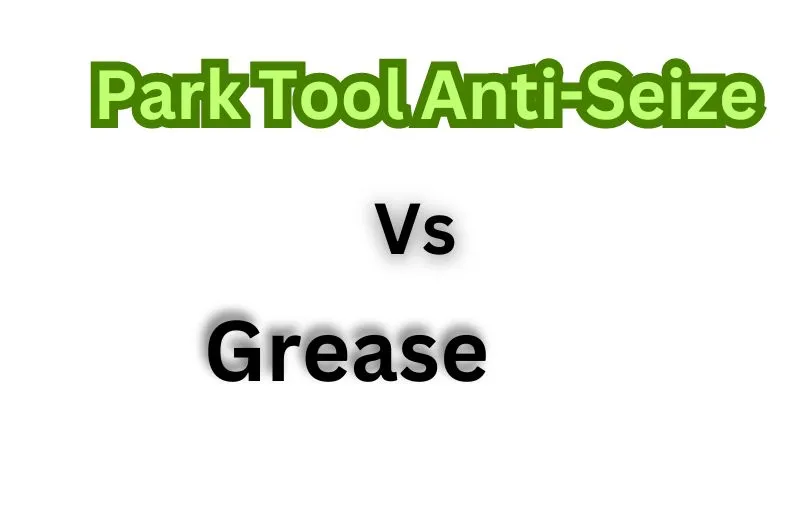As a passionate cyclist, I understand the importance of keeping my bike in top condition. One of the key aspects of bike maintenance is proper lubrication. It ensures smooth and efficient performance and helps prevent wear and tear on the various components. When it comes to lubricating your bike, you have two main options to consider: Park Tool Anti-Seize vs Grease.
In this article, I will discuss the differences between these two lubricants and help you choose the best option for your bike.
Table of Contents
Anti-Seize Vs Grease
Before we delve deeper into the difference between Park Tool Anti-Seize vs Grease, let’s first understand the basic differences between anti-seize and grease. Anti-seize is a lubricant that is specifically designed to prevent corrosion and seizing of metal parts. It contains a high concentration of metallic particles, such as copper or aluminum, which act as a barrier between the metal surfaces, preventing them from sticking together.
On the other hand, grease is a semi-solid lubricant that is made by mixing oil with a thickening agent, such as lithium or calcium soap. It is used to reduce friction between moving parts and provide long-lasting lubrication.
The Importance of Lubricating Your Bike
Lubricating your bike is essential for maintaining its performance and prolonging its lifespan. When the various components of your bike are properly lubricated, they move smoothly and efficiently, resulting in a more enjoyable ride.
Additionally, lubrication helps prevent corrosion and rust, which can cause irreversible damage to your bike’s metal parts. By regularly lubricating your bike, you not only ensure its optimal functioning but also save yourself from costly repairs in the long run.
When to Use Anti-Seize
Anti-seize is particularly useful in situations where metal parts are prone to seizing or becoming stuck together due to corrosion. It is commonly used on threaded components, such as pedals, bottom brackets, and headset bearings. These parts are exposed to moisture and dirt, which can lead to corrosion over time. By applying anti-seize to these components, you create a protective barrier that prevents corrosion and makes it easier to disassemble them when needed.
It is important to note that anti-seize should not be used as a general-purpose lubricant. Its high concentration of metallic particles can attract dirt and debris, causing unnecessary wear on other bike components. Therefore, it is best to use anti-seize only in specific situations where corrosion and seizing are likely to occur.
When to Use Grease
Grease, on the other hand, is a versatile lubricant that can be used in a wide range of applications on your bike. It is commonly used on bearings, such as wheel hubs, bottom brackets, and headset bearings. Grease provides long-lasting lubrication and helps reduce friction between the moving parts, ensuring smooth operation. Additionally, grease also acts as a sealant, preventing water and dirt from entering the bearings and causing damage.
Apart from bearings, grease can also be used on other moving parts, such as derailleur pivots and brake pivots. It helps reduce friction and ensures smooth movement, enhancing the overall performance of your bike. However, it is important to use the right type of grease for each application, as different bike components require different properties from the lubricant.
Comparing the Pros and Cons of Anti-Seize vs Grease
Both anti-seize and grease have their advantages and disadvantages, and choosing the right option depends on the specific application.
Pros of Anti-Seize:
- It provides excellent corrosion protection
- Prevents seizing of metal parts
- Allows for easy disassembly when needed
Cons of Anti-Seize:
- Attracts dirt and debris, causing unnecessary wear on other components
- Not suitable for general-purpose lubrication
Pros of Grease:
- Provides long-lasting lubrication
- Reduces friction between moving parts
- Acts as a sealant, preventing water and dirt from entering bearings
Cons of Grease:
- Requires the use of different types for different applications
- May attract dirt and debris if not applied properly
Related Guide: How to Quiet Noisy Strut Mounts: A Step-by-Step Guide (2024)?
How to Apply Anti-Seize Properly
When applying anti-seize to your bike components, it is important to follow a few key steps to ensure proper application. First, make sure to clean the metal surfaces thoroughly to remove any dirt or debris.
Then, apply a thin and even layer of anti-seize to the threaded or metal surfaces using a brush or a clean cloth. Be careful not to over-apply, as excess anti-seize can attract dirt and cause unnecessary wear. Finally, tighten the components to the manufacturer’s recommended torque specifications.
How to Apply Grease Properly
Applying grease to your bike components requires a similar approach to anti-seize. Start by cleaning the parts thoroughly to remove any dirt or old grease. Then, apply a thin and even layer of grease to the moving parts or bearings, ensuring complete coverage.
Use a brush or your fingers to spread the grease evenly. Finally, reassemble the components and make sure they are tightened to the appropriate torque specifications.
Choosing Amongst Park Tool Anti-Seize vs Grease for Different Bike Components
When it comes to choosing the right lubricant for different bike components, it is important to consider the specific requirements of each part. As mentioned earlier, anti-seize is best suited for threaded components that are prone to corrosion and seizing. Grease, on the other hand, is suitable for bearings and other moving parts that require long-lasting lubrication and reduced friction.
It is also worth noting that Park Tool offers a range of lubricants specifically formulated for different bike components. For example, Park Tool offers a specific grease for wheel bearings, another one for bottom brackets, and even a special assembly compound for carbon fiber parts. By choosing the right lubricant for each component, you can ensure optimal performance and longevity.
Conclusion
Choosing the right lubricant for your bike depends on each component’s specific application and requirements. While anti-seize is ideal for preventing corrosion and seizing of threaded parts, grease is a versatile lubricant that provides long-lasting lubrication and reduces friction. By understanding the differences between Anti-Seize and Grease, and considering the specific needs of your bike components, you can make an informed decision.
When it comes to Park Tool anti-size vs. grease, both have their advantages and disadvantages. Park Tool Anti Seize provides excellent corrosion protection and prevents the seizing of metal parts, while grease offers long-lasting lubrication and acts as a sealant. The choice between the two ultimately depends on the specific needs of your bike and the components you are working with.
So, next time you are performing bike maintenance, make sure to choose the right lubricant for the job. Whether it’s Park Tool Anti Seize or Grease, proper lubrication will keep your bike running smoothly and ensure a more enjoyable ride. Happy cycling!

